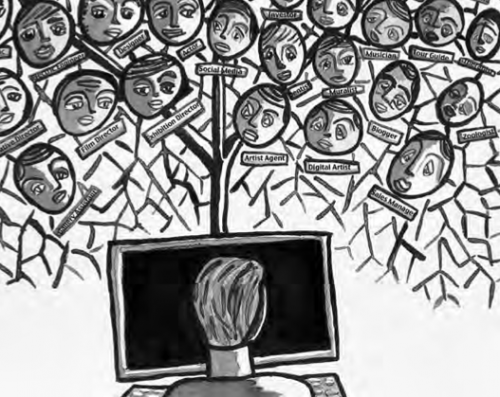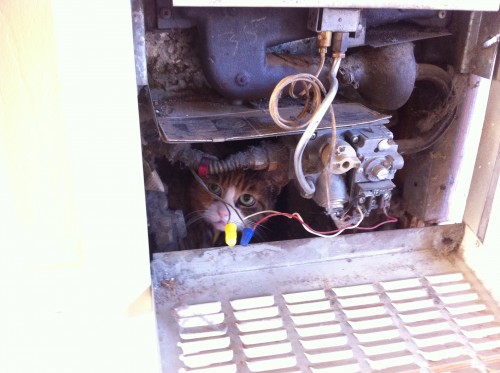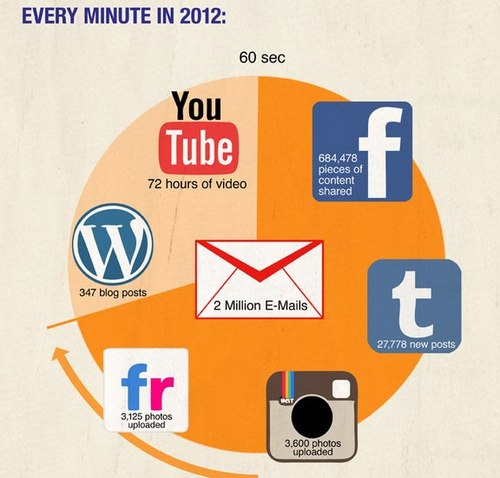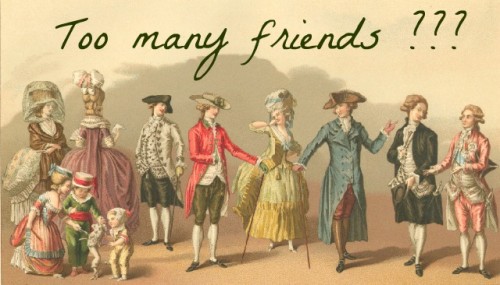“Well, you saw what I posted on Facebook, right?”
I don’t know about you, but when I get this question from a friend, my answer is usually “no.” No, I don’t see everything my friends post on Facebook—not even the 25 or so people I make a regular effort to keep up with on Facebook, and not even the subset of friends I count as family. I don’t see everything most of my friends tweet, either; in fact, “update Twitter lists” has been hovering in the middle of my to-do list for the better part of a year. And even after I update those lists, I probably still won’t be able to keep up with everything every friend says on Twitter, either.
I feel guilty when I get the “You saw what I posted, right?” question. I feel like a bad friend, like I’m slacking off in my care work, like I’m failing to value my important human relationships. Danah boyd (@zephoria) was talking about something similar two nights ago at “Boom and Bust“—about how social networking sites create pressure to put time and effort into tending weak ties, and how it can be impossible to keep up with them all. Personally, I also find it difficult to keep up with my strong ties. I’m a great “pick up where we left off” friend, as are most of the people closest to me (makes sense, right?). I’m decidedly sub-awesome, however, at being in constant contact with more than a few people at a time.

Anyway, I have a bad case of Social Media Saturation Guilt, and “You saw what I posted, right?” hits that guilt square on its head. Recently, however, I’ve been thinking about how the awkward collisions of online and offline conversation used to run in the opposite direction. Twelve years ago[i] I was on an email list that was basically a private, 70-someodd person pre-Facebook: members shared links, asked questions, had serious conversations, sent invitations to parties, and circulated photos taken at those parties after they happened. It wasn’t uncommon to talk about something someone had posted to “the list” in face-to-face conversation, whether in small groups or at larger events.
Then, over a period of a month or two, most of us on “the list” got on Livejournal, and most of us who had Livejournals started ‘reading’ most of the rest of us who had Livejournals. (Yeah, Livejournal. We’re back in late 2000, remember?)
The affordances of Livejournal being what they are, most of us posted different content to our Livejournals than we did to “the list.” The intersection of Livejournal content and in-person conversation, however, wasn’t as seamless as the intersection of list content and in-person conversation. A new phenomenon popped up that a good portion of “the list” found anywhere from off-putting to downright hurtful, and it looked something like this:
The Scene: a “list” party.
List Member A: Hey, it’s good to see you! What have you been up to recently?
List Member B: [Starts to tell story]—
List Member A: [Cuts off List Member B] Yeah, I know. I read your Livejournal.
These aborted conversations became common enough that they spawned a long, intense debate on “the list” about what should be the proper etiquette for intersections of Livejournal and life-in-the-moment. Some list members felt it was rude and insensitive for friends to cut each other off; other list members felt it was rude and entitled for friends to expect each other to sit through the same story twice. The eventual compromise was to declare a sort of ‘best practice,’ which was that List Member A should signal being caught up with List Member B’s Livejournal by chiming in with a detail from the story: “Oh yeah! But then you found your cat hiding in the wall, right?” List Member B, on the other hand, should truncate the story accordingly: “Yeah! I have no idea how she got in there!”

So how did the Awkward Party Comment shift from “I know, I read your Livejournal” to “You read what I posted on Facebook, right?” There’s a simple explanation, which is that each of us was probably consuming less friend-generated and friend-circulated digital content back then. This could be because those of us on “the list” were just maintaining fewer digital connections in 2000, but there’s also the mode of communication to consider: though some list members juggled multiple different list subscriptions, and Livejournal, and usenet or BBS groups, all of these revolved primarily around text-based communication, and original text takes time to create (something of which I’m particularly aware at the moment, as I write this). When the rate of friend-content production was slower, it was easier to consume most if not all of what our friends produced and circulated.
Yet I don’t think this shift in content production alone explains the shift in social expectation. I think there’s something else in play, which I’m going to call the devolution of friendship. As I explain over the course of this two-part essay, I link the devolution of friendship to—but do not “blame” it on—the affordances of various social networking platforms, especially (but not exclusively) so-called “frictionless sharing” features.
What does “devolution” mean? I’m using the word here in the same way that people use it to talk about the devolution of health care. One example of devolution of health care is some outpatient surgeries: patients are allowed to go home after their operations, but they still require a good deal of post-operative care such as changing bandages, irrigating wounds, administering medications, etc. Whereas before these patients would stay in the hospital and nurses would perform the care-labor necessary for their recoveries, patients must now find their own caregivers (usually family members or friends; sometimes themselves) to perform free care-labor. In this context, devolution marks the shift of labor and responsibility away from the medical establishment and onto the patient; within the patient-medical establishment collaboration, the patient must now provide a greater portion of the necessary work. Similarly, in some ways, we now expect our friends to do a greater portion of the work of being friends with us.
[Obligatory “We” Check: by “we,” here I mean some social media users some of the time. I’m not saying that all social media users’ expectations have shifted in this way, or that any given social media user’s friendship expectations are uniform across different friends, times, or contexts, or that the devolution of friendship applies only to people who use social media. Got it? Ok good.]

Through social media, “sharing with friends” is rationalized to the point of relentless efficiency. The current apex of such rationalization is frictionless sharing: we no longer need to perform the labor of telling our individual friends about what we read online, or of copy-pasting links and emailing them to “the list,” or of clicking a button for one-step posting of links on our Facebook walls. With frictionless sharing, all we have to do is look, or listen; what we’ve read or watched or listened to is then “shared” or “scrobbled” to our Facebook, Twitter, Tumblr, or whatever other online profiles. Whether we share content actively or passively, however, we feel as though we’ve done our half of the friendship-labor by ‘pushing’ the information to our walls, streams, and tumblelogs. It’s then up to our friends to perform their halves of the friendship-labor by ‘pulling’ the information we share from those platforms.
When we think about this form of “bulk sharing” from our perspectives as content-creators and circulators, there are ways in which it seems like a good thing. We’re busy people; we like the idea of making one announcement on Facebook and being done with it, rather than having to repeat the same story over and over again to different friends individually. We also like not always having to think about which friends might like which stories or songs; we like the idea of sharing with all of our friends at once, and then letting them sort out who is and isn’t interested amongst themselves. Though social media can create burdensome expectations to keep up with strong ties, weak ties, and everyone in between, social media platforms can also be very efficient. Using the same moment of friendship-labor to tend multiple friendships at once kills more birds with fewer stones.
There are also ways in which we like being on the “more labor” side of devolution. For instance, sometimes we like the devolution of health care: if we are privileged enough to have people who can perform the necessary care-labor for us, many of us would prefer to recover from surgery in the comfort of our own homes rather than in hospitals. Theorists point out that we provide free labor when we use self-checkout machines at grocery stores and pharmacies, but to some of us that ‘free labor’ is a small price to pay for getting in and out faster, for waiting in a shorter line, and for not dealing with (“dealing with”) another human being at a conventional checkout counter.

Similarly, sometimes we like the devolution of friendship. When we have to ‘pull’ friendship-content instead of receiving it in a ‘push’, we can pick and choose which content items to pull. We can ignore the baby pictures, or the pet pictures, or the sushi pictures—whatever it is our friends post that we only pretend to care about (if we even bother to pretend). Whether we interact through digital media, through the telephone, or through speech in face-to-face conversations, socializing with specific individual friends requires that we mask our disinterest in [babies/pets/sushi/other] by actively ‘smiling and nodding,’ in one form or another. The non-specific sharing of devolved friendship, however, lets us skip this step. We can leave it to everyone else to respond, or tell ourselves that our sushi baby pet friend isn’t really talking to us in particular. Within devolved friendship interactions, it takes less effort to be polite while secretly waiting for someone to please just stop talking.
So if we like devolved friendship from the perspective of both share-producers and share-consumers, what’s the problem? While I won’t go so far as to say they’re definitely ‘problems,’ there are two major things about devolved friendship that I think are worth noting. The first is the non-uniform rationalization of friendship-labor, and the second is the depersonalization of friendship-labor. I’ll explore both of these in the coming week, in Part II of this essay.
Someecard image from http://www.someecards.com/birthday-cards/it-would-be-significantly-easier-to-wish
Social media saturation image from http://contexts.org/articles/spring-2012/too-many-friends/
Photo of Antigone in wall heater by Whitney Erin Boesel. Used with permission.
Social media production rates image from http://spectacularoptical.tumblr.com/post/33773042893
Too many friends image from http://cupidscharm.blogspot.com/2012/06/can-you-have-too-many-friends.html
[i] Oh noes, I’m old. Crap. 😛


Comments 19
Social Media and the Devolution of Friendship: Part I » Cyborgology | The Digital Self | Scoop.it — October 20, 2012
[...] [...]
Boaz — October 21, 2012
I appreciated this article, Whitney, and look forward to reading the next installment. It seems like what's missing in the devolved friendship is a real sense of commitment. If we view our friends as people creating content that we may or may not access depending on our time available and mood, then we could also feel that if they are in real trouble its not our responsibility. I think the limit on how many friends we can reasonably have is not just in terms of our attention span and ability to follow what they write and view photos, etc, but also in terms of what we have to offer back. A friendship should have at least some sense of mutual responsibility, and if one spreads oneself too thin, one can't keep one's end of the bargain on this.
Boaz — October 21, 2012
Another difference between "the list" you mention, and Livejournal or Facebook would be the size involved. If there are a maximum of 70 people involved in something, then over time you get a feeling for the boundary of the communication within that context. Even if you write in a somewhat undirected way, over time, the group is small enough that something like community could form. With a much larger social network, there is dissipation. The dissipation and spread is good for some things. But for developing mutually caring relationships, with a sense of responsibility towards a group you care about and feel a member of, probably not so good.
Anyway, interesting to see this development in dynamics, (from your list, to Livejournal, to Facebook) and see that its not always necessarily an improvement.
Doug Hill — October 21, 2012
This is really good stuff...thanks. You help me understand why I've found Facebook friendship more satisfying than I thought I would -- because it's not so much satisfying as it is convenient. Jacques Ellul said that the primary value of technique is efficiency. He also said that technique "desacralizes" everything that is sacred. What this article says about friendship seems to fit both descriptions.
Social Media and the Devolution of Friendship: Part I » Cyborgology | La scimmia nuda e Internet | Scoop.it — October 21, 2012
[...] [...]
La lettre du 22 octobre : la conquête de l’Ouest numérique ? | Proxem, le blog — October 22, 2012
[...] Cet article passionnant décrit la transition induite par l’apparition des « réseaux sociaux » à proprement parler. Au travers de la généralisation de la pratique sociale du web, des réseaux comme Facebook finissent par banaliser l’échange. Là où l’on pouvait précédemment dire à des amis, autour d’un verre, « oui, je connais cette histoire, tu en as déjà parlé sur Internet », on se retrouve plutôt aujourd’hui à dire « tu as vu le lien que j’ai posté sur Facebook ? » et à devoir répondre par la négative. C’est la conséquence de la multiplication des échanges sociaux : on ne peut plus suivre, et paradoxalement, les réseaux sociaux génèrent moins d’échanges authentiques que le web avant leur apparition. [...]
Social Media and the Devolution of Friendship: Part I » Cyborgology | Mesh | Scoop.it — October 22, 2012
[...] [...]
Social Media and the Devolution of Friendship: Part II » Cyborgology — October 24, 2012
[...] from “I know, I read your Livejournal” to “You read what I posted on Facebook, right?” As I explained last week, this change is related to what I call the devolution of friendship. In devolved friendship, we [...]
Rob — October 24, 2012
In a way the "You saw what I posted, right?” problem is ameliorated by the way Facebook determines what updates to show people algorithmically. One can say, "It's not my fault I didn't see your update; Facebook buried it on my feed." Blame shifts to the user for not being an active enough FB user to boost their EdgeRank (or not being willing to sponsor their posts quasi-surreptitiously)
Social Media and the Devolution of Friendship: Part I » Cyborgology | Digital Research for Humanities | Scoop.it — October 24, 2012
[...] I don’t know about you, but when I get this question from a friend, my answer is usually “no.” No, I don’t see everything my friends post on Facebook—not even the 25 or so people I make a regular effort to keep up with on Facebook, and not even the subset of friends I count as family. I don’t see everything most of my friends tweet, either; in fact, “update Twitter lists” has been hovering in the middle of my to-do list for the better part of a year. And even after I update those lists, I probably still won’t be able to keep up with everything every friend says on Twitter, either. [...]
Social Media and the Devolution of Friendship: Part I » Cyborgology | Philosophy, Thoughts and Society | Scoop.it — October 24, 2012
[...] [...]
Social Media and the Devolution of Friendship: Part I » Cyborgology | Digital Technology and Life | Scoop.it — October 24, 2012
[...] [...]
Social Media and the Devolution of Friendship: Part I » Cyborgology | Teorías sociales, filosóficas y algo más | Scoop.it — October 25, 2012
[...] I don’t know about you, but when I get this question from a friend, my answer is usually “no.” No, I don’t see everything my friends post on Facebook—not even the 25 or so people I make a regular effort to keep up with on Facebook, and not even the subset of friends I count as family. I don’t see everything most of my friends tweet, either; in fact, “update Twitter lists” has been hovering in the middle of my to-do list for the better part of a year. And even after I update those lists, I probably still won’t be able to keep up with everything every friend says on Twitter, either. [...]
Social Media and the Devolution of Friendship: Part I » Cyborgology | Social Media Director | Scoop.it — October 25, 2012
[...] I don’t know about you, but when I get this question from a friend, my answer is usually “no.” No, I don’t see everything my friends post on Facebook—not even the 25 or so people I make a regular effort to keep up with on Facebook, and not even the subset of friends I count as family. I don’t see everything most of my friends tweet, either; in fact, “update Twitter lists” has been hovering in the middle of my to-do list for the better part of a year. And even after I update those lists, I probably still won’t be able to keep up with everything every friend says on Twitter, either. [...]
Social Media and the Devolution of Friendship: Part I » Cyborgology | UX of the Future | Scoop.it — October 28, 2012
[...] I don’t know about you, but when I get this question from a friend, my answer is usually “no.” No, I don’t see everything my friends post on Facebook—not even the 25 or so people I make a regular effort to keep up with on Facebook, and not even the subset of friends I count as family. I don’t see everything most of my friends tweet, either; in fact, “update Twitter lists” has been hovering in the middle of my to-do list for the better part of a year. And even after I update those lists, I probably still won’t be able to keep up with everything every friend says on Twitter, either. [...]
“social” versus “Social” » Cyborgology — November 1, 2012
[...] interaction into concepts more comfortable and familiar. It is easier to swallow massive changes to interpersonal norms, expectations, and behaviors when such shifts are repackaged and presented as the delightful idea of [...]
Social Media and the Devolution of Friendship: Full Essay (Pts I & II) » Cyborgology — December 18, 2012
[...] is the full version of a two-part essay that I posted in October of this year. Here are links to Part I and Part [...]
Proxem » La lettre du 22 octobre : la conquête de l’Ouest numérique ? — May 16, 2013
[...] Cet article passionnant décrit la transition induite par l’apparition des « réseaux sociaux » à proprement parler. Au travers de la généralisation de la pratique sociale du web, des réseaux comme Facebook finissent par banaliser l’échange. Là où l’on pouvait précédemment dire à des amis, autour d’un verre, « oui, je connais cette histoire, tu en as déjà parlé sur Internet », on se retrouve plutôt aujourd’hui à dire « tu as vu le lien que j’ai posté sur Facebook ? » et à devoir répondre par la négative. C’est la conséquence de la multiplication des échanges sociaux : on ne peut plus suivre, et paradoxalement, les réseaux sociaux génèrent moins d’échanges authentiques que le web avant leur apparition. [...]
Proxem » La lettre du 22 octobre : la conquête de l’Ouest numérique ? — October 31, 2013
[…] Cet article passionnant décrit la transition induite par l’apparition des « réseaux sociaux » à proprement parler. Au travers de la généralisation de la pratique sociale du web, des réseaux comme Facebook finissent par banaliser l’échange. Là où l’on pouvait précédemment dire à des amis, autour d’un verre, « oui, je connais cette histoire, tu en as déjà parlé sur Internet », on se retrouve plutôt aujourd’hui à dire « tu as vu le lien que j’ai posté sur Facebook ? » et à devoir répondre par la négative. C’est la conséquence de la multiplication des échanges sociaux : on ne peut plus suivre, et paradoxalement, les réseaux sociaux génèrent moins d’échanges authentiques que le web avant leur apparition. […]